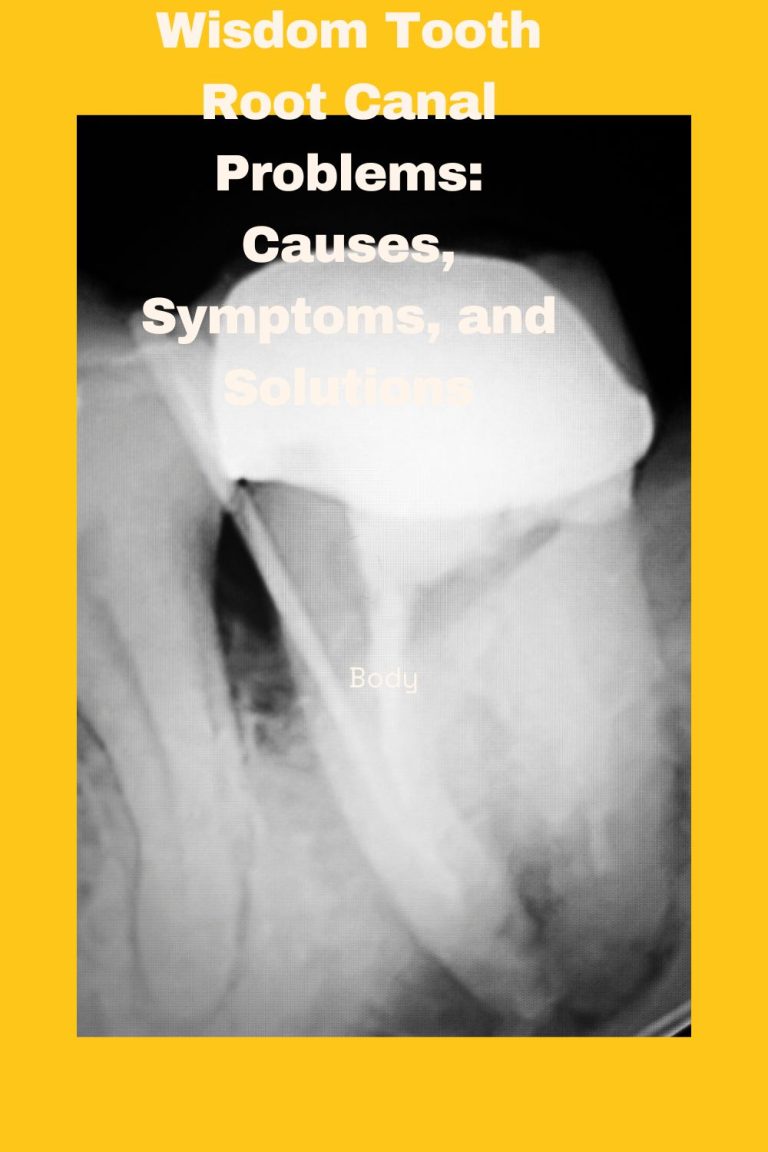Bicuspid Root Canal: A Pain-Free Solution for Improved Oral Health
Last Updated on 6 months by DR. ALBIN SIPES
A bicuspid root canal is a dental procedure that involves removing infected pulp from the root canals of a bicuspid tooth. This procedure helps alleviate pain and prevent further damage or infection to the tooth.
Welcome to our guide on the bicuspid root canal procedure. Dental health is essential, and sometimes, issues such as infection or damage can occur, leading to the need for dental treatments. The bicuspid root canal is one such treatment that aims to address the problems with the root canals of bicuspid teeth.
We will explore what a bicuspid root canal is, why it is necessary, and what to expect during the procedure. Read on to learn more about this important dental treatment option.
What Is A Bicuspid Root Canal?
A bicuspid root canal is a dental procedure that involves treating the roots of bicuspid teeth. These teeth, also known as premolars, are located between the molars and canines. During a bicuspid root canal, the dentist carefully removes the infected pulp from the root canal and cleans the area.
This is done to alleviate pain, prevent further damage, and save the tooth from extraction. Bicuspid teeth play a crucial role in dental health as they help with chewing and supporting the structure of the mouth. It is essential to take proper care of these teeth by maintaining good oral hygiene habits, such as brushing and flossing regularly and visiting the dentist for routine check-ups.
By doing so, you can ensure the longevity and health of your bicuspid teeth.
Signs And Symptoms Of Bicuspid Root Canal Problems
Bicuspid root canal problems can lead to various dental issues that require attention. Some common signs and symptoms to watch out for include:
- Severe tooth pain.
- Sensitivity to hot or cold foods.
- Swelling or tenderness around the affected area.
- A persistent unpleasant taste in the mouth.
Additionally, you may experience difficulty in chewing or biting, as well as discoloration of the tooth. If you notice any of these symptoms, it is essential to consult a dentist as soon as possible. Prompt diagnosis and treatment can help prevent further complications and preserve the health of your teeth.
Please don’t ignore these warning signs, as they could indicate the need for a bicuspid root canal procedure. Trust your dental professional to guide you through the process and restore your oral health.
Causes Of Bicuspid Root Canal Issues
Bicuspid root canal issues can occur due to various factors. Dental habits and lifestyle choices play a crucial role in contributing to these problems. Poor oral hygiene and neglect of dental care can lead to the development of cavities and infections in the bicuspid teeth.
Consuming excessive sugary and acidic foods can erode the enamel, leaving the teeth vulnerable to decay. Tobacco use and smoking can also weaken the teeth and increase the risk of root canal issues. Additionally, trauma or injury to the bicuspid teeth can damage the pulp and require root canal treatment.
It is vital to maintain good dental habits, such as regular brushing, flossing, and visiting the dentist, to minimize the chances of developing bicuspid root canal problems. Taking care of our oral health is essential for our overall well-being.
Relieving Dental Pain And Discomfort
Bicuspid root canal treatment offers an effective solution for relieving dental pain and discomfort. This procedure can alleviate pain caused by common dental problems. By targeting the affected bicuspid tooth, the root canal treatment helps to eliminate infection or inflammation.
It involves the removal of damaged pulp from the tooth’s inner chamber. The dentist then cleans and disinfects the area before filling and sealing it. This process not only relieves pain but also saves the tooth from extraction. Having a bicuspid root canal can restore normal oral function and prevent further complications.
It is a reliable and long-lasting solution for those experiencing dental discomfort. If you are struggling with dental pain, consult with your dentist to determine if bicuspid root canal treatment is suitable for you.
Preserving Natural Teeth
Preserving natural teeth is essential, especially when it comes to bicuspid root canal treatment. Root canal treatment is crucial for keeping the strength and functionality of natural teeth. By undergoing this procedure, patients can save their teeth from extraction and maintain their genuine smile.
The importance of preserving natural teeth through root canal treatment cannot be overstated. It not only helps in restoring oral health but also allows individuals to enjoy long-term benefits. Bicuspid teeth play a vital role in chewing and biting, making it crucial to preserve them.
This treatment ensures that the natural teeth are saved and can continue to fulfill their function. With the benefits of maintaining bicuspid teeth through root canal treatment, individuals can enjoy better oral health and overall well-being.
Improving Oral Health And Overall Well-Being
Bicuspid root canal treatment plays a crucial role in improving oral health and overall well-being. It is essential to understand the close link between oral health and our overall health. Neglecting oral health can lead to various systemic diseases and infections.
By removing the infected pulp and repairing the damaged tooth, bicuspid root canal treatment eliminates pain and prevents further dental issues. This procedure not only restores oral health but also contributes to general well-being. Regular dental check-ups, proper oral hygiene practices, and prompt treatment of dental problems are vital for maintaining good overall health.
Seeking professional dental care and understanding the importance of bicuspid root canal treatment can significantly impact oral health and ensure a higher quality of life. It is crucial to prioritize oral health as a part of overall well-being.
The Role Of Local Anesthesia In Bicuspid Root Canal Procedures
Local anesthesia plays a crucial role in ensuring a painless experience during bicuspid root canal procedures. By numbing the area, dentists effectively manage pain. The dentist carefully does the administration of local anesthesia to guarantee a comfortable and pain-free treatment.
This can be achieved through various techniques, such as infiltration or block anesthesia. The dentist will carefully select the appropriate method based on the patient’s needs. The precise administration of local anesthesia ensures that the patient remains at ease throughout the procedure.
The use of local anesthesia not only alleviates pain but also contributes to a successful and efficient root canal treatment. Dentists prioritize patient comfort and pain management, making local anesthesia an essential aspect of bicuspid root canal procedures.
The Steps Involved In Bicuspid Root Canal Treatment
Bicuspid root canal treatment involves a step-by-step process utilizing advanced technologies and instruments. The procedure begins with the dentist administering local anesthesia to ensure a pain-free experience. Next, they create a small access hole in the affected tooth to reach the canals.
Using specialized tools, the dentist carefully removes the infected pulp and cleans the canals. Once the canals are thoroughly disinfected, they are shaped to accommodate the filling material. The dentist then fills the canals with a biocompatible material and seals them to prevent reinfection.
In some cases, a temporary filling is placed on top. Finally, a permanent restoration, such as a dental crown, may be recommended to protect the restored tooth. Bicuspid root canal treatment aims to relieve pain and save the natural tooth, providing lasting oral health benefits.
Post-Treatment Care And Recovery
After undergoing a bicuspid root canal, it is crucial to follow proper aftercare instructions for optimal healing and recovery. To minimize discomfort and maintain oral health post-procedure, here are some essential tips to keep in mind. First, avoid excessively using common phrases like “when it comes to” or “if you.”
Remember to follow these guidelines for successful post-treatment care and recovery.
Frequently Asked Questions Of Bicuspid Root Canal
What Is A Bicuspid Root Canal?
A bicuspid root canal is a dental procedure to remove infected pulp from the root of a bicuspid tooth. The procedure involves:
- Cleaning and disinfecting the root canal.
- Filling it with a biocompatible material.
- Sealing it to prevent further infection.
Why Is A Bicuspid Root Canal Necessary?
A bicuspid root canal is necessary when the pulp inside the tooth becomes infected or inflamed due to deep decay, tooth fracture, or repeated dental procedures. If left untreated, the infection can spread, causing severe pain, abscess formation, and eventual tooth loss.
What Are The Signs That A Bicuspid Root Canal Might Be Needed?
Signs that a bicuspid root canal might be needed include:
- Persistent toothache.
- Sensitivity to hot or cold.
- Swelling around the tooth.
- Gum tenderness.
- Discoloration of the affected tooth.
It is essential to consult a dentist for a proper diagnosis and appropriate treatment.
How Long Does A Bicuspid Root Canal Procedure Take?
The duration of a bicuspid root canal may vary depending on the complexity of the case, but it typically takes about one to two hours to complete. Factors such as the number of canals and the presence of infection can also influence the procedure’s length.
Is A Bicuspid Root Canal A Painful Procedure?
With modern dental techniques and local anesthesia, a bicuspid root canal should not be painful, as the infected tooth’s nerves are removed during the procedure. Some patients may experience mild discomfort or soreness afterward, which can be managed with over-the-counter pain medication.
Conclusion
Getting a bicuspid root canal is an effective solution to save a damaged tooth and alleviate pain. By removing the infected pulp and sealing the canals, a dentist can prevent further decay and restore the tooth’s functionality. The procedure is relatively simple and can be completed in a few visits, providing long-term benefits.
Additionally, the success rate of bicuspid root canals is high, ensuring that patients can enjoy a healthy smile for years to come. It is crucial to maintain proper oral hygiene practices and seek regular dental check-ups to prevent future dental issues.
If you are experiencing tooth pain or suspect that you may need a root canal, don’t delay seeking professional dental care. Remember, early intervention can save your tooth and help you maintain optimal oral health.



